The school year is starting. Families are returning home from their vacation travels with souvenirs and many fond memories; children are eager to tell their classmates what they did on their summer vacations.
But unfortunately, many families’ travels brought them face-to-face with the hyper-gendered marketing that now targets children so relentlessly: Princess culture is infiltrating educational, historic sites–even though it has no business there.
For example, last week, Lauren visited Pearl Harbor with her family. She sent me snapshots from the Pearl Harbor Visitor Center of “Princess Park Ranger” vests for girls, and “Junior Ranger” vests for boys:
 Pink “Princess Park Ranger” vests for the girls; neutral “Junior Ranger” vests for the boys. Pearl Harbor Visitor Center. Photo by Lauren Huntoon – @laurenhuntoon
Pink “Princess Park Ranger” vests for the girls; neutral “Junior Ranger” vests for the boys. Pearl Harbor Visitor Center. Photo by Lauren Huntoon – @laurenhuntoon
Lauren asked a clerk for more information about the vests, which retail for $30 and come in children’s sizes XS – L. She learned that the visitor center began stocking these vests about three months ago. Since then, they have been really popular: “Little girls love them,” the clerk told Lauren. “They put them on and they think they are princesses.”
But–what the heck is a princess park ranger, and why do marketers believe little girls need to feel like they are princesses at all times?
There is no need for gift shops attached to educational and historic sites to capitalize on little girls’ princess fantasies. It’s a safe bet that none of the park rangers at Pearl Harbor wear bright pink vests and tiaras. Here’s a thought: Instead of engaging girls in the shallowest possible way, with pink princess kitsch that has nothing to do with the site or its history, why not engage them authentically, with products reflecting the history of the site or the region? (Queen Liliuokalani shirts, perhaps?)
Sadly, the princessification underway at the Pearl Harbor Visitor’s Center is not unusual. Last summer, I wrote about how the Boston Museum of Science’s gift shop had recoated the gender-neutral concept of science with sparkly, pink, purple nonsense about princesses and other stereotypically girly traits. Soon afterwards, I heard from another vacationer whose family encountered an entire wall of pink princessy souvenirs at the Kennedy Space Center Visitor’s Complex, under the label of “NASAGIRL.” A glance around the area was informative for its emphasis on the pink, the pretty, and the sparkly:
And what do NASAGIRLs aspire to be? Are there science-oriented toys for them to purchase? T-shirts boasting about their intellect and prowess?
No–NASA apparently isn’t invested in products that would boost girls’ self-esteem while they learn about science. Instead, they deliver up “Space Princess” merchandise–which is so odd, really, as I still really don’t understand what that moniker even means. (If someone called me a space princess, wouldn’t it be an insult–a way of saying I’m a girly space-shot?)
We can glean some information about what makes a “space princess” by considering the other merchandise available. Apparently, space princesses like Hello Kitty–an adorable, pink-loving, girly-girl icon–for Kitty gets an entire section of the NASAGIRL area:
Below Hello Kitty is the NASA Space Crew Barbie. As far as dolls go, I have to say that this one is pretty cool–I would definitely give one of these to the girls in my life rather than so many of the other dolls on the market! I also am pleased to see that her crew uniform is in a realistic blue, not bright pink. (Thank goodness.)
Despite the “win” for Barbie, the section as a whole is depressing, limiting girls to shallow pink-loving princesses–who, likely being stereotypically moody tweens, “need their space.”
What can we make of all this princess marketing? From a marketing perspective, this is true laziness: Marketers, unsure of how to engage with girls in authentic terms, are using “princess” as shorthand. It means, “Hey, girls–over here! This is for you. Buy this.” Therefore, “Space” + “princess” = space stuff for girls.
It doesn’t have to be this way, though. For example, during my family’s trip to San Francisco last week, we did not encounter princess marketing at The Exploratorium: Their gift shop categorized items by age and interest, not by gender.(Even the Exploratorium’sonline gift shop is set up in a similarly gender-neutral way: their major product categories include “make,” “play,” “read,” “see and hear,” and “wear,” rather than the ubiquitous “boys” and “girls” segregation by sex.)
And, guess what? The Exploratorium gift shop was filled with children who were excited by its offerings. No one seemed confused by the lack of gender-based directives. I didn’t see any children scratching their heads, wondering which products were meant for them. It was clear: like the exhibits at the Exploratorium, these products were for everybody.
But clearly, our experience is in danger of becoming the exception to the rule. Why is it so hard for gift shops, ESPECIALLY those attached to educational institutions, to wrap their heads around the idea that kids are kids–not diametrically opposed “opposite sexes”? Boys and girls have more similarities than differences between them. If an institution’s mission is to educate and inform children, they should reach out to all kids with their souvenir offerings. Engaging in the divide-and-conquer tactics used by mainstream retailers is unnecessary–and insulting.
Tell the gift shops what you think:
—-
Rebecca Hains is a media studies professor at Salem State University in Salem, Mass. Follow her on Facebook and Twitter.